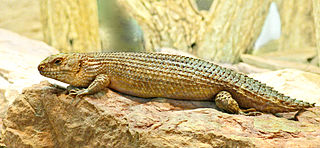
Stokes's sea snake is a large species of sea snake in the family Elapidae. It is sometimes placed in its own genus Astrotia. The species is endemic to tropical Indo-Pacific oceanic waters.
Hernandia beninensis is a species of plant in the Hernandiaceae family. It is endemic to São Tomé and Príncipe and is listed as near threatened by the IUCN.
Hernandia catalpifolia is a species of plant in the Hernandiaceae family. It is endemic to Jamaica. It is threatened by habitat loss.
Hernandia cubensis is a species of plant in the Hernandiaceae family. It is endemic to Cuba. It is threatened by habitat loss.
Hernandia didymantha is a species of plant in the family Hernandiaceae. It is found in Colombia, Costa Rica, Honduras, Nicaragua, and Panama.
Hernandia drakeana was a species of plant in the Hernandiaceae family. It was endemic to French Polynesia.
Hernandia hammelii is a species of plant in the Hernandiaceae family. It is endemic to Panama. It is threatened by habitat loss.
Hernandia jamaicensis is a species of plant in the Hernandiaceae family. It is endemic to Jamaica.
Hernandia lychnifera is a species of plant in the Hernandiaceae family. It is endemic to Ecuador. Its natural habitats are subtropical or tropical moist lowland forests and subtropical or tropical moist montane forests.
Hernandia mascarenensis is a species of plant in the Hernandiaceae family. It is found in Mauritius and Réunion.
Hernandia nukuhivensis is a species of plant in the Hernandiaceae family. It is endemic to French Polynesia.
Hernandia stenura is a species of plant in the Hernandiaceae family. It is found in Costa Rica, Nicaragua, and Panama.
Hernandia tahitensis is a species of plant in the Hernandiaceae family. It is endemic to French Polynesia.
Hernandia temarii is a species of plant in the Hernandiaceae family. It is endemic to French Polynesia.
Ixora stokesii is a species of flowering plant in the family Rubiaceae. It is endemic to the island Rapa-Iti in French Polynesia.
Myoporum stokesii is a plant in the figwort family, Scrophulariaceae and is endemic to the island of Raivavae in French Polynesia. It is similar to the two other members of its genus on the island, Myoporum rapense and Myoporum rimatarense although the former has serrated leaves and the latter has wider leaves and differently shaped fruits.
Homalanthus stokesii is a species of plant in the family Euphorbiaceae. It is endemic to French Polynesia.
This is a list of the flora of the Tubuai, an island in French Polynesia.

Hernandia is a genus of flowering plants in the family Hernandiaceae. It was named after the Spanish botanist Francisco Hernández de Toledo.

Egernia stokesii is a gregarious species of lizard of the Scincidae family. This diurnal species is endemic to Australia, and is also known as the Gidgee skink, spiny-tailed skink, Stokes's skink and Stokes's egernia. The species forms stable, long-term social aggregations, much like the social groups seen in mammalian and avian species. This characteristic is rarely found in the Squamata order, but is widespread within the Australian subfamily of Egerniinae skinks. Populations of E. stokesii are widely distributed, but fragmented, and occur in semi-arid environments. There are three recognised subspecies. The conservation status for the species is listed as least concern, however, one subspecies is listed as endangered.



